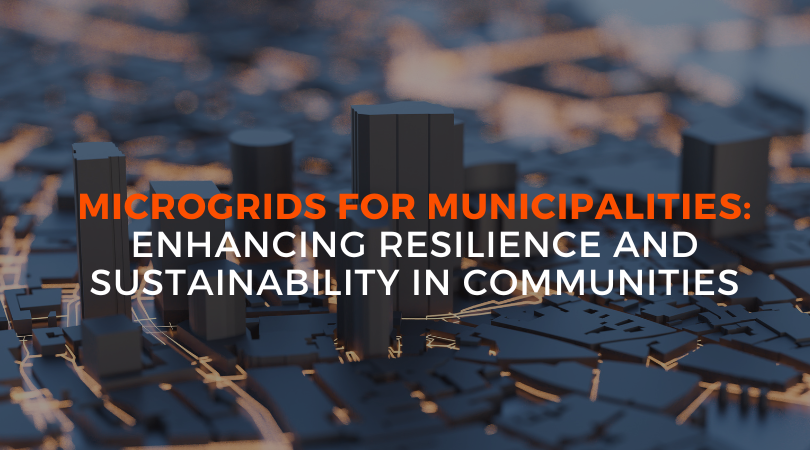Microgrids for Municipalities: Enhancing Resilience and Sustainability in Communities
The need for sustainability, innovative solutions are becoming more critical than ever. Microgrids are emerging as a transformative answer—offering municipalities the ability to enhance energy resilience, reduce costs, and create greener, more sustainable communities. In an age of unpredictable weather, rising energy demands, and the shift towards renewable energy, microgrids present a localized, flexible, and reliable energy solution that can be tailored to meet the unique needs of cities, towns, and regions. In this blog, we’ll dive into why microgrids are so vital for municipalities and how they pave the way to a more sustainable, resilient future.
1. Boosting Energy Resilience and Reliability
Municipalities are responsible for critical infrastructure such as water treatment plants, emergency services, and public transportation. Ensuring these services remain operational during power outages is vital for the safety and well-being of residents. Microgrids offer a reliable solution by providing a decentralized energy source that can continue to operate independently during emergencies.
Example: During a natural disaster, when the central grid may be compromised, a microgrid can keep essential services running, ensuring water treatment facilities, traffic signals, and emergency shelters remain powered and functional.
2. Driving Cost Savings and Economic Stability
Municipalities often operate within tight budget constraints, and energy costs can be a significant burden. Microgrids can reduce these costs by improving energy efficiency and utilizing locally generated renewable energy. By avoiding peak demand charges and reducing reliance on expensive fossil fuels, municipalities can achieve significant long-term savings.
Example: A municipality that installs solar panels and battery storage as part of its microgrid can generate electricity during the day and store excess energy for use during peak demand hours. This strategy reduces the need to purchase costly electricity from the grid, leading to lower utility bills.
3. Supporting Sustainability and Environmental Stewardship
As municipalities work toward reducing their carbon footprints and meeting sustainability targets, microgrids present an opportunity to integrate renewable energy sources into their energy mix. By incorporating solar, wind, and other renewable energy resources, municipalities can reduce their reliance on fossil fuels and significantly cut greenhouse gas emissions.
Example: A city that deploys a microgrid powered by solar energy and wind turbines can drastically reduce carbon emissions, leading to cleaner air and a healthier environment for residents.
4. Fostering Local Economic Development
Microgrids can act as a catalyst for local economic growth by creating jobs in the renewable energy sector and encouraging investment in local energy infrastructure. Additionally, by providing reliable power, microgrids attract businesses and industries that require a stable energy supply, further boosting the local economy.
Example: A town that develops a microgrid could see an increase in local jobs related to the installation, operation, and maintenance of the system. Furthermore, businesses such as data centers or manufacturing facilities, which depend on a continuous power supply, may be more likely to set up operations in areas with reliable microgrids.
5. Enhancing Energy Independence
Microgrids provide municipalities the ability to generate their own power, reducing dependence on external energy sources. This is particularly beneficial for remote or rural communities vulnerable to disruptions in the central grid. By producing and managing their own energy, municipalities can take greater control over their energy future.
Example: A rural municipality that adopts a microgrid powered by local renewable resources, such as wind or hydropower, ensures a stable and consistent energy supply without relying on distant power plants or vulnerable transmission lines.
6. Strengthening Emergency Preparedness
In times of crisis, whether due to natural disasters or grid failures, municipalities must be prepared. Microgrids enhance emergency preparedness by providing a reliable, self-sustaining power source that can be quickly activated. This ensures critical services remain operational, minimizing the impact on residents and speeding recovery efforts.
Example: In the aftermath of a hurricane, a microgrid ensures emergency response centers, hospitals, and communication networks remain powered, facilitating efficient disaster response and recovery.
7. Providing Flexibility and Scalability
Microgrids offer municipalities the flexibility to tailor energy solutions based on their specific needs. Whether for a small town or a large city, microgrids can be scaled up or down to provide the right amount of energy for various applications. This scalability makes them an ideal solution for municipalities of all sizes.
Example: A small town might start with a microgrid powering municipal buildings, and as the community grows, expand it to include schools, residential areas, and commercial districts.
8. Ensuring Compliance with Regulatory Requirements
As environmental regulations tighten, municipalities face increasing pressure to reduce their carbon emissions and transition to clean energy. Microgrids help municipalities meet these regulations by integrating renewable energy sources and improving overall energy efficiency.
Example: A city facing new state mandates to cut carbon emissions might implement a microgrid that includes solar panels and battery storage systems. This would help the city comply with regulations while providing a reliable power source.
Wrapping Up
As municipalities face mounting pressures to ensure energy security, sustainability, and economic resilience, microgrids emerge as a vital tool to address these challenges head-on. By offering greater control over energy production, reducing costs, and supporting environmental goals, microgrids not only enhance the reliability of critical services but also foster long-term community growth and prosperity. Embracing this transformative energy solution allows municipalities to safeguard their future while leading the way toward a more sustainable, self-sufficient, and resilient world. The time is now for municipalities to invest in microgrids and pave the path to a stronger, more sustainable future for all.

